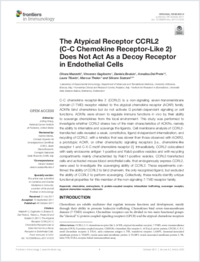The atypical receptor CCRL2 (C-C Chemokine Receptor-Like 2) does not act as a decoy receptor in endothelial cells
- Mazzotti, Chiara Laboratory of Experimental Immunology, Department of Molecular and Translational Medicine, University of Brescia, Brescia, Italy
- Gagliostro, Vincenzo Laboratory of Experimental Immunology, Department of Molecular and Translational Medicine, University of Brescia, Brescia, Italy
- Bosisio, Daniela Laboratory of Experimental Immunology, Department of Molecular and Translational Medicine, University of Brescia, Brescia, Italy
- Del Prete, Annalisa Laboratory of Experimental Immunology, Department of Molecular and Translational Medicine, University of Brescia, Brescia, Italy - Humanitas Clinical and Research Centre, Rozzano, Italy
- Tiberio, Laura Laboratory of Experimental Immunology, Department of Molecular and Translational Medicine, University of Brescia, Brescia, Italy
- Thelen, Marcus Institute for Research in Biomedicine (IRB), Faculty of Biomedical Sciences, Università della Svizzera italiana, Switzerland
- Sozzani, Silvano Laboratory of Experimental Immunology, Department of Molecular and Translational Medicine, University of Brescia, Brescia, Italy - Humanitas Clinical and Research Centre, Rozzano, Italy
-
06.10.2017
Published in:
- Frontiers in immunology. - 2017, vol. 8, p. 1233
Chemokine
Endocytosis
G protein-coupled receptor
Intracellular trafficking
Scavenger receptor
Atypical chemokine receptor
Chemerin
English
C-C chemokine receptor-like 2 (CCRL2) is a non-signaling seven-transmembrane domain (7-TMD) receptor related to the atypical chemokine receptor (ACKR) family. ACKRs bind chemokines but do not activate G protein-dependent signaling or cell functions. ACKRs were shown to regulate immune functions in vivo by their ability to scavenge chemokines from the local environment. This study was performed to investigate whether CCRL2 shares two of the main characteristics of ACKRs, namely the ability to internalize and scavenge the ligands. Cell membrane analysis of CCRL2-transfected cells revealed a weak, constitutive, ligand-independent internalization, and recycling of CCRL2, with a kinetics that was slower than those observed with ACKR3, a prototypic ACKR, or other chemotactic signaling receptors [i.e., chemokine-like receptor 1 and C-X-C motif chemokine receptor 2]. Intracellularly, CCRL2 colocalized with early endosome antigen 1-positive and Rab5-positive vesicles and with recycling compartments mainly characterized by Rab11-positive vesicles. CCRL2-transfected cells and activated mouse blood endothelial cells, that endogenously express CCRL2, were used to investigate the scavenging ability of CCRL2. These experiments confirmed the ability of CCRL2 to bind chemerin, the only recognized ligand, but excluded the ability of CCRL2 to perform scavenging. Collectively, these results identify unique functional properties for this member of the non-signaling 7- TMD receptor family.
- Language
-
- English
- Classification
- Medicine
- License
- Open access status
- gold
- Identifiers
-
- RERO DOC 327165
- DOI 10.3389/fimmu.2017.01233
- ARK ark:/12658/srd1319167
- Persistent URL
- https://n2t.net/ark:/12658/srd1319167
Statistics
Document views: 173
File downloads:
- Texte intégral: 187
